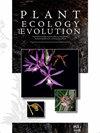Moss phyllid morphology varies systematically with substrate slope
IF 1.1
4区 生物学
Q3 PLANT SCIENCES
引用次数: 2
Abstract
Background and aims – Tracheophyte leaf morphology is well studied but it is unclear if the findings generalize to poikilohydric plants. We tested combinations of hypotheses to determine if microhabitat characteristics, including light exposure, moisture availability, and substrate slope, controlled for morphological differences between upright and prostrate growth forms, affect phyllid surface area and costa length of mosses.Material and methods – We quantified mean phyllid surface-area and costa lengths for four replicates of 38 moss species from Alabama. Phylogenetic comparative methods that model adaptation were used to evaluate the relative evidence for each hypothesis using information criteria. To further explore mechanistic explanations involving substrate slope, we tested whether mosses on vertical substrates differed from those on horizontal substrates in the average amount of water-retaining, nutrient-rich litter they accumulated.Key results – Substrate slope and growth form combined were the best predictors of phyllid surface area. Mosses growing on vertical substrates exhibited smaller phyllid surface area for both growth forms. Although growth form and phyllid length best explained costa length variation, a more complex model including substrate slope performed nearly as well. Within the prostrate growth forms, species growing on vertical substrates exhibit longer relative costa than those on horizontal substrates. We also estimated rapid rates of adaptation for both traits.Conclusion – The smaller phyllid surface area of both upright and prostrate growth forms is possibly an adaptive response to reduced habitat moisture-retention or nutrient quality that vertical substrates offer. The longer costa lengths of prostrate mosses growing on vertical surfaces relative to prostrate mosses on horizontal surfaces, possibly make up for the decreased ability of smaller phyllids to rapidly reabsorb water when it is available. Further work is required to determine if it is truly substrate slope itself that matters or other variables associated with the differences in slope, and to determine how general this phenomenon is.苔藓叶面形态随基质坡度有系统的变化
背景和目的-对管生植物的叶片形态进行了充分的研究,但尚不清楚这些发现是否适用于多水植物。我们测试了各种假设的组合,以确定微生境特征(包括光照、水分有效性和基质坡度)是否能控制直立和匍匐生长形式之间的形态差异,从而影响苔藓的叶根表面积和柱顶长度。材料和方法:我们量化了阿拉巴马州38种苔藓的4个重复的平均叶面面积和长度。采用模型适应的系统发育比较方法,利用信息标准对每个假设的相关证据进行评价。为了进一步探索涉及基质坡度的机制解释,我们测试了垂直基质上的苔藓与水平基质上的苔藓在平均保水和富营养凋落物积累量方面是否存在差异。关键结果-基质坡度和生长形式相结合是phyllid表面积的最佳预测因子。在垂直基质上生长的苔藓,两种生长形式的叶根表面积都较小。虽然生长形式和叶根长度最好地解释了costa长度的变化,但包括基质坡度在内的更复杂的模型几乎也能解释。在匍匐生长形式中,生长在垂直基质上的物种比生长在水平基质上的物种表现出更长的相对长度。我们还估计了这两种性状的快速适应速度。结论:直立和匍匐生长形式的叶根表面积都较小,这可能是对垂直基质提供的栖息地水分保持或营养质量降低的适应性反应。相对于生长在水平面上的匍匐苔藓,生长在垂直表面的匍匐苔藓的茎长更长,这可能弥补了较小的phyllids在有水时迅速再吸收水分的能力下降。需要进一步的工作来确定是否真的是基底坡度本身的问题,还是与坡度差异相关的其他变量的问题,并确定这种现象有多普遍。
本文章由计算机程序翻译,如有差异,请以英文原文为准。
求助全文
约1分钟内获得全文
求助全文
来源期刊

Plant Ecology and Evolution
PLANT SCIENCES-
CiteScore
2.20
自引率
9.10%
发文量
27
审稿时长
>12 weeks
期刊介绍:
Plant Ecology and Evolution is an international peer-reviewed journal devoted to ecology, phylogenetics and systematics of all ‘plant’ groups in the traditional sense (including algae, cyanobacteria, fungi, myxomycetes), also covering related fields.
The journal is published by Meise Botanic Garden and the Royal Botanical Society of Belgium.
 求助内容:
求助内容: 应助结果提醒方式:
应助结果提醒方式:


